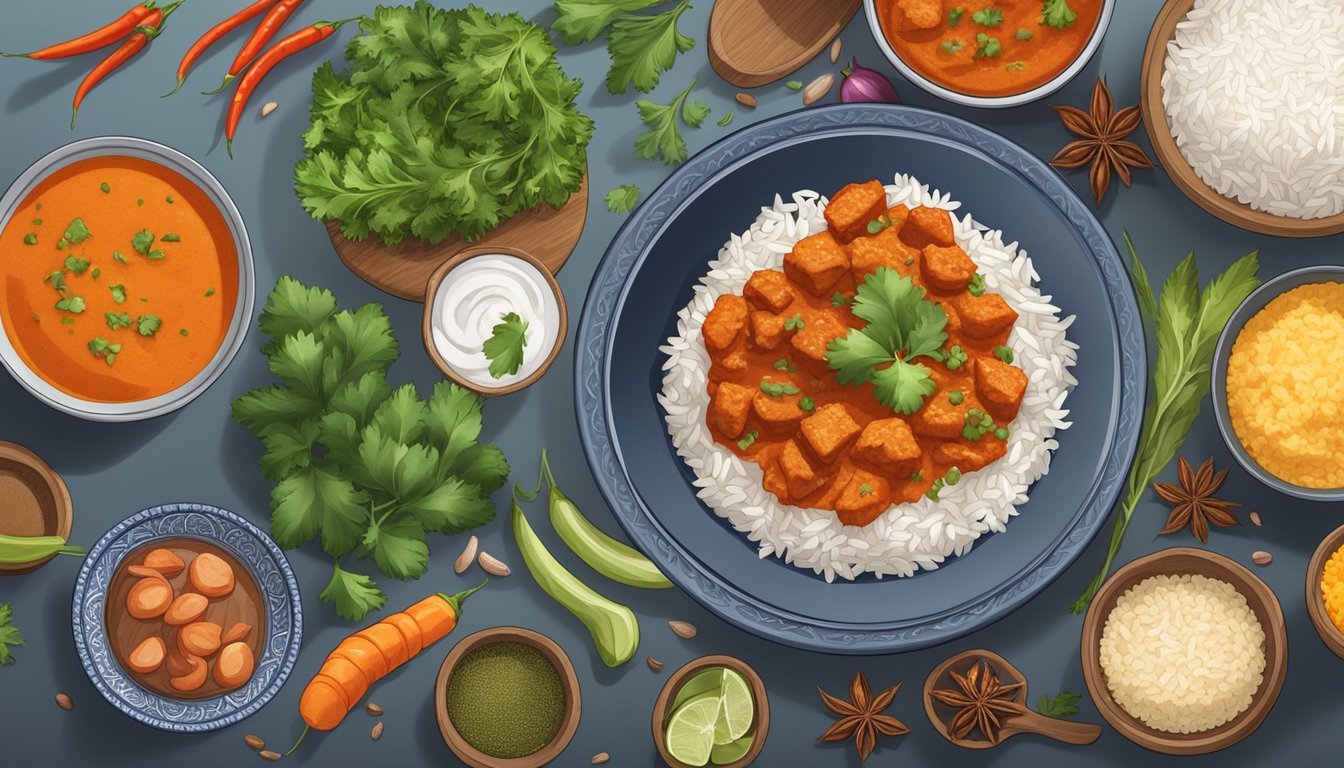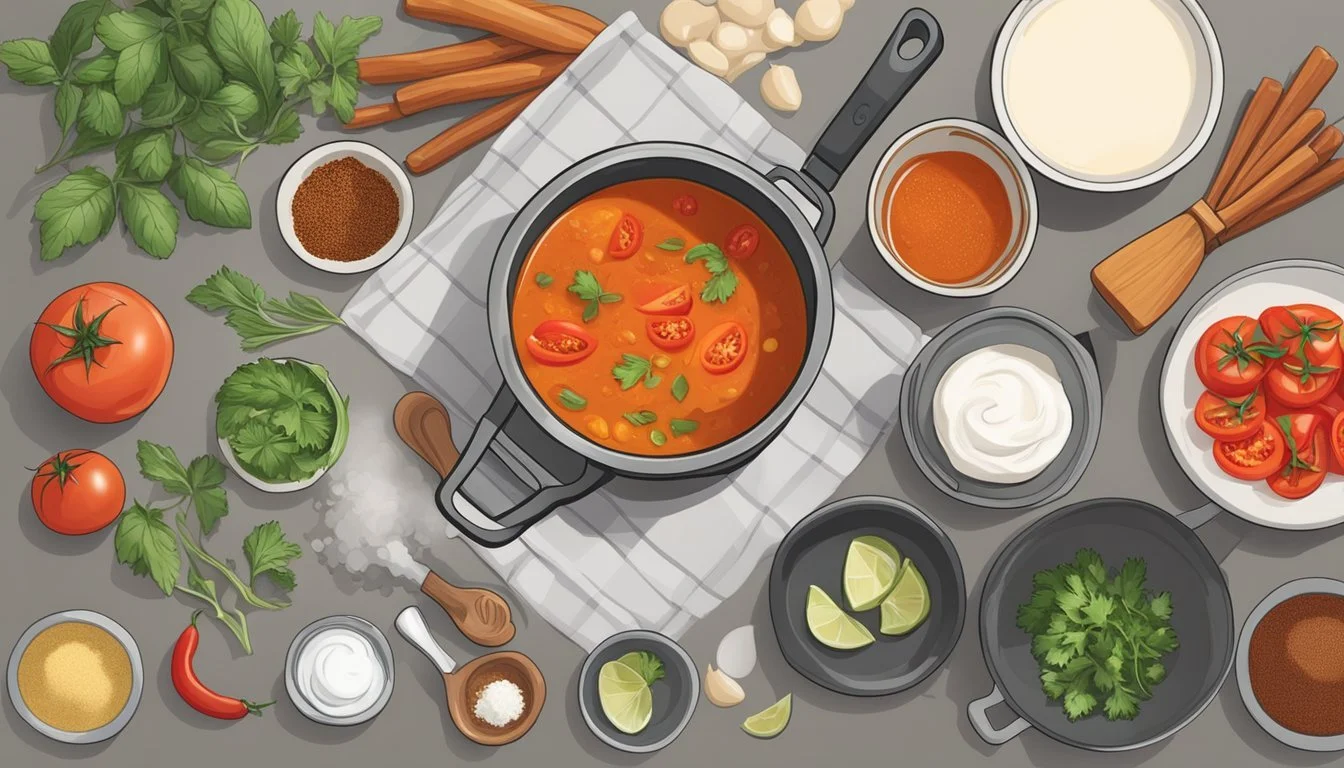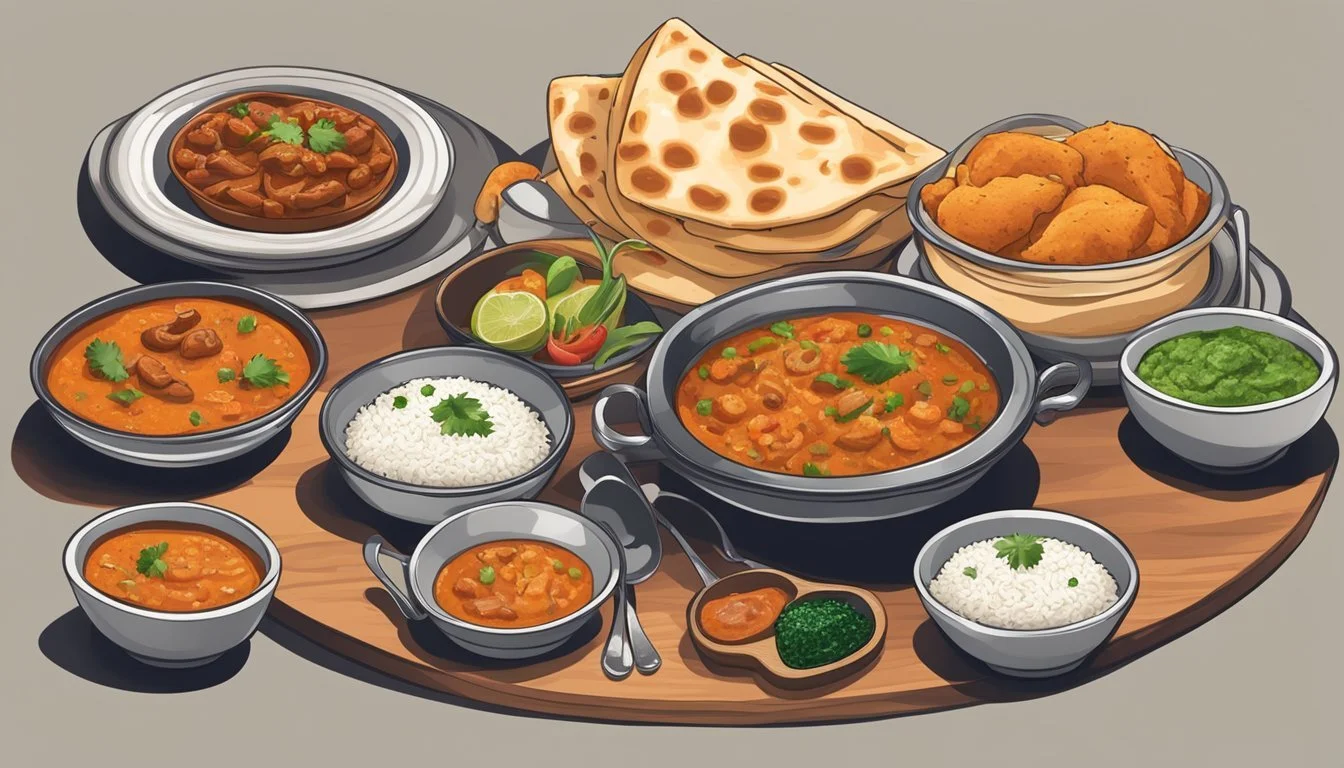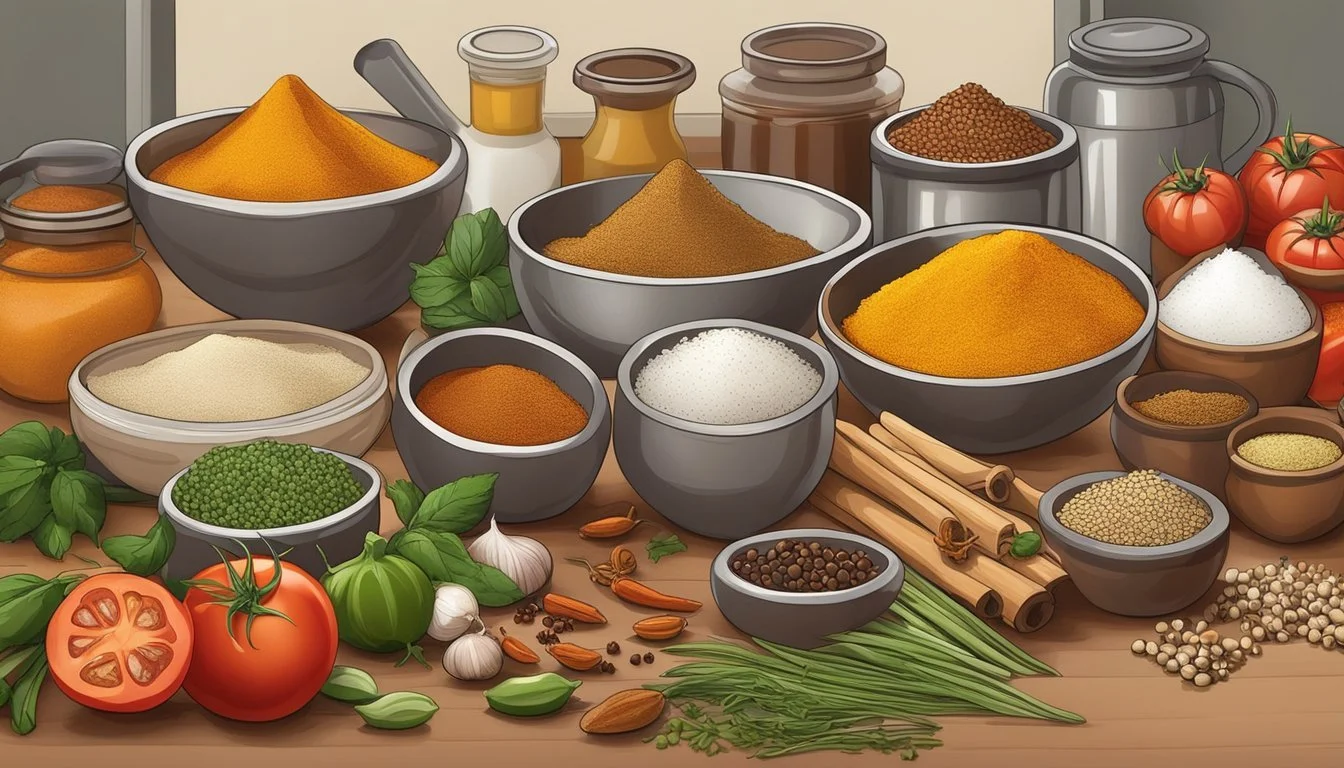Is Tikka Masala Gluten-Free?
Understanding Its Ingredients and Recipe Options
Tikka Masala, a celebrated Indian dish, has traveled far from its South Asian origins to grace tables around the world. Its hearty blend of marinated meat, typically chicken, bathed in a creamy tomato sauce is a culinary delight. However, those with dietary restrictions, such as a gluten intolerance, often approach Indian cuisine with caution, given the prevalence of wheat-based ingredients in certain recipes.
With the increasing awareness and requirements for gluten-free options, it becomes pertinent to examine Tikka Masala in the context of a gluten-free diet. Indian cuisine is known for its use of a vast spectrum of spices and legumes, many of which are naturally without gluten. Typically, the base ingredients of Tikka Masala – chicken, yogurt, tomatoes, and an array of spices—are free from gluten.
Nonetheless, variations in preparation methods and the addition of certain thickeners or flavorings could introduce gluten into the dish. Identifying gluten-free versions of Tikka Masala involves careful scrutiny of ingredients and preparation practices, whether dining out or cooking at home. It is a paramount consideration for ensuring the dish aligns with the dietary needs of those avoiding gluten, without compromising on the authentic flavors of this Indian staple.
Understanding Gluten-Free Diets
A gluten-free diet excludes the protein gluten, found in grains such as wheat, barley, and rye. This diet is essential for individuals with celiac disease, an autoimmune disorder where gluten ingestion leads to damage in the small intestine. Symptoms of celiac disease include diarrhea, bloating, weight loss, and malnutrition due to impaired nutrient absorption.
Those with non-celiac gluten sensitivity may also benefit from a gluten-free diet, as they can experience symptoms similar to those with celiac disease, but without the intestinal damage. Gluten-related allergies, like wheat allergy, are another reason one might adopt a gluten-free lifestyle.
Health Considerations: A gluten-free diet is necessary for managing symptoms and preventing complications associated with the aforementioned conditions. However, it is crucial to note that "gluten-free" does not inherently mean "healthy". Gluten-free products can still be high in calories, fats, and sugars with low nutritional value. Thus, people should carefully choose whole, naturally gluten-free foods and read labels when selecting processed options.
Do Don't - Choose natural foods that are inherently gluten-free, such as fruits, vegetables, meats, and fish. - Assume all gluten-free products are healthy. - Read product labels to ensure they are gluten-free. - Overlook possible gluten contamination in oats. - Consider whole grains like quinoa, rice, and buckwheat that are gluten-free. - Ignore nutrient deficiencies that might occur from eliminating gluten-containing grains.
For anyone considering a gluten-free diet, consulting with a healthcare provider or a dietitian is advised to ensure nutritional adequacy and to receive personalized dietary guidance.
The Fundamental Ingredients of Tikka Masala
Tikka Masala is a beloved dish known for its rich flavor profile, hinging on a balance of proteins, a variety of produce, and a symphony of spices. Here, we explore the core components that make up this classic, comforting meal.
Proteins and Bases
The protein of choice for Chicken Tikka Masala (What wine goes well with chicken tikka masala?) is typically chicken breasts or chicken thighs (What wine goes well with chicken thighs?). Chicken thighs are often favored for their juiciness and flavor. These proteins act as the foundation of the dish and are marinated, then grilled or baked, before being enrobed in the masala sauce. In terms of bases, various types of rice such as basmati rice, brown rice, or white rice frequently accompany the dish as a side staple, complementing the robust flavors of the masala.
Vegetables and Fruits
The masala sauce primarily includes tomatoes, which can be in the form of diced tomatoes or tomato sauce. Their acidity and sweetness form the backbone of the sauce's flavor profile. An onion usually acts as the aromatic base, sautéed until tender and sweet. Sometimes, fresh cilantro is added towards the end of cooking for a burst of herbaceous freshness.
Herbs and Spices
The complexity of Tikka Masala’s sauce comes from the careful layering of spices. Garam masala—a blend of ground spices like cumin, coriander, turmeric, clove, and cinnamon—is a key component that imparts warmth and depth. Ginger, either as fresh ginger or ginger paste, and garlic add pungent, aromatic heat. These spices not only provide the signature flavors but also contribute to the dish's inviting aroma.
Preparing the Tikka Masala Sauce
The secret to a delightful Tikka Masala sauce lies in the rich flavors developed during its preparation. A traditional sauce includes a spice-laden masala base often enriched with dairy, but for those seeking a gluten-free and potentially healthier alternative, there are dairy-free options that do not sacrifice taste.
Creating the Masala Base
One begins by preparing the masala base, which serves as the foundation of the sauce. The process typically involves:
Heating oil: A healthy oil such as olive oil is often used to sauté aromatics due to its subtle flavor that doesn't overpower the spices.
Sautéing the aromatics: This includes onions, garlic, and ginger, which are cooked until tender. These ingredients are essential for creating a deep and nuanced flavor profile.
Spice introduction: Traditional Indian spices such as garam masala, turmeric, cumin, and paprika are then stirred in, releasing their robust aromas and flavors into the base.
Tomato incorporation: Tomato paste, and sometimes diced tomatoes, are included to impart acidity and sweetness balancing the spice.
Cooking duration: The mixture is usually simmered carefully, allowing the spices to cook down into a fragrant and thick blend.
Incorporating Dairy Alternatives
For individuals with dietary restrictions or those looking for a lower-fat option, dairy components like cream can be substituted:
Dairy-free alternatives: Coconut milk, which adds a creamy texture and a hint of sweetness, can replace cream making the dish lactose-free and potentially healthier by cutting down on saturated fat.
Stirring in the alternative: The chosen dairy-free alternative is incorporated slowly into the masala base, blending until the sauce achieves the desired creamy consistency.
It's important to note that while many Indian restaurants traditionally use cream, home recipes often modify this component to cater to nutritional preferences or dietary needs without compromising the sauce's heartiness or authenticity.
Accompaniments and Side Dishes
When crafting a gluten-free meal featuring Tikka Masala, the selection of side dishes can enrich the dining experience by complementing the main dish's flavors and providing a balance in nutrition.
Ideal Rice Selections
Rice serves as a staple accompaniment for Tikka Masala, often acting as a vehicle to absorb the sauce and provide a texture contrast. A gluten-free option that works well is Basmati rice, which offers a fragrant aroma and a fluffy texture. Each serving of plain Basmati rice contributes a substantial amount of carbohydrates, essential for energy, but minimal fiber, protein, or fat.
Pilau rice, another aromatic option, can carry herbs and spices that echo the ones found in Tikka Masala. While choosing rice varieties, it is fundamental to ensure that they are not mixed with flavors or additives containing gluten, especially for those with celiac disease or gluten sensitivities. Pure Basmati or Pilau rice without added seasoning is typically gluten-free, but always check the labels for confirmation.
Complementary Vegetables
Vegetables add color, fiber, and vital nutrients to a dinner serving of Tikka Masala while keeping the calories in check. They should be selected not only for their nutritional benefits but also for their ability to harmonize with the rich and spicy profile of the main dish.
Carrots, for example, can be cut into strips or diced and lightly seasoned to preserve their natural sweetness, complementing the masala's heat. They provide fiber and a host of vitamins with relatively few calories.
Serving a blend of sautéed or roasted vegetables, like bell peppers and onions, can further elevate the meal. These vegetables contribute additional fiber and a variety of textures.
For those who might incorporate rice flour into their meal as a thickening agent or in gluten-free bread recipes, it is important to verify that the flour is produced in a gluten-free facility to avoid cross-contamination.
Gluten-Free Cooking Techniques
When preparing a gluten-free version of Tikka Masala, certain cooking techniques are paramount to maintain the integrity of the dish, while ensuring it’s safe for individuals with gluten sensitivities.
Marinating: In gluten-free cooking, marinating the chicken is a crucial step to infuse flavor. One should opt for gluten-free ingredients like yogurt, gluten-free spices, and lemon juice. An immersion blender or food processor can be employed to blend the marinade to a smooth consistency before coating the chicken thoroughly.
Grilling/Skillet: To mimic the traditional char and depth of flavor, grilling the marinated chicken is ideal. However, for convenience or weather constraints, using a skillet or frying pan with a drizzle of gluten-free oil on medium-high heat will suffice. Ensure that the pan is strictly used for gluten-free cooking to avoid cross-contamination.
Frying: High-temperature frying, either in a frying pan or skillet, can create the signature sear crucial for developing flavors. However, chefs must ensure that any spices added during this stage are certified gluten-free, and any thickening agents used should be appropriate substitutes such as cornstarch or a gluten-free flour blend.
Cooking Technique Kitchen Tool Considerations Marinating Immersion Blender/Food Processor Use gluten-free ingredients Grilling Grill Provides traditional char Skillet Cooking Skillet/Frying Pan Ensure no cross-contamination with gluten products
It’s vital to maintain a kitchen environment free of gluten contaminants. Chefs should always check labels for hidden gluten and keep gluten-free cookware and utensils separate. Utilizing these techniques will lead to a delicious and safe gluten-free Tikka Masala.
Adapting the Recipe for Gluten Sensitivity
When modifying traditional Chicken Tikka Masala to be gluten-free, careful attention to ingredients becomes crucial. Ingredients that typically contain gluten, such as certain seasonings and sauces, must be substituted with gluten-free alternatives.
Ingredients Swap:
Spices: Ensure that each individual spice, such as garam masala and paprika, is labeled gluten-free to avoid cross-contamination.
Thickeners: Use cornstarch or a gluten-free flour blend as a thickening agent instead of wheat flour.
Sauces: Opt for a gluten-free certified tomato paste to steer clear of hidden gluten.
A gluten-free Chicken Tikka Masala can still boast the rich, creamy texture and robust flavor profile one expects from the dish. They may use fresh ingredients and homemade spice blends to control the contents. Here is a simplified breakdown for an allergy-friendly version:
Use fresh chicken pieces, marinated in gluten-free yogurt and spices.
Cook the marinated chicken in a skillet with gluten-free olive or coconut oil.
Prepare a masala sauce with gluten-free items such as butter, onions, garlic, ginger, cumin, and a gluten-free cream substitute.
Simmer the sauce until it thickens to desired consistency.
Serve over rice or with gluten-free naan.
By these means, individuals with gluten sensitivity can enjoy a homemade gluten-free Chicken Tikka Masala that is both satisfying and safe. The key is vigilance in selecting ingredients that meet gluten-free standards and a consistent approach to preventing cross-contact with gluten-containing products. With these practices, the dish remains flavorful, creamy, and, most importantly, allergy-friendly.
Serving and Presentation Tips
When serving Tikka Masala, presentation can significantly enhance the dining experience. An attractive dish not only looks appealing but can also emphasize the rich, savory flavors.
Plating Technique:
Arrange the Tikka Masala centrally in a bowl or on a plate, creating a mound with the meat and sauce.
Drizzle a spoonful of sauce over the top to showcase its creamy texture.
Enhancing Flavor:
Lemon or Lime Juice: A splash of lemon or lime juice just before serving can brighten the dish's flavor.
Fresh Ginger: Finely grated fresh ginger adds a zesty kick that complements the spice blend.
Garnishment:
Cilantro: Chopped fresh cilantro provides a burst of freshness and color contrast.
Use a small amount of cilantro for a subtle flavor or a larger quantity for a more pronounced taste.
Individual Portions:
Serve single servings in a small saucepan to maintain the temperature and add authenticity to the presentation.
For family-style dinner, present the Tikka Masala in a large serving bowl, allowing guests to help themselves.
Complementary Sides:
Offer a side of naan or gluten-free bread for guests to enjoy the savory sauce.
A simple salad with a light lemony dressing can balance the rich flavor of Tikka Masala.
By adhering to these tips, the culinary creation is not only tasty and flavorful but also visually appealing, promising a delightful dining experience.
Health and Nutritional Information
Chicken Tikka Masala is a popular dish whose nutritional content can vary depending on the preparation method. This dish can be adapted to be gluten-free, which makes it a suitable option for individuals with celiac disease or gluten sensitivity.
Nutritional Composition:
Calories: A typical serving of Chicken Tikka Masala contains approximately 270 calories.
Fat: It consists of around 8 grams of fat, which can change depending on the use of cooking oils or dairy.
Protein: Each serving generally provides 17 grams of protein, crucial for muscle repair and growth.
Carbohydrates: This dish has roughly 31 grams of carbohydrates, offering energy for daily activities.
Fiber: Depending on the amount of tomato and onion used, the fiber content can contribute to the recommended daily intake.
Micronutrients:
A serving of Chicken Tikka Masala provides certain micronutrients which are beneficial for health. For example, the tomatoes and spices included may supply a source of calcium.
Nutrient Estimated Amount (per serving) Protein 17 grams Carbohydrates 31 grams Fat 8 grams Fiber Variable Calcium Variable
Health Considerations:
For a healthier version, chefs may opt for low-fat dairy options or cooking sprays to reduce the overall fat content. Gluten-free Tikka Masala avoids the use of wheat-containing ingredients, ensuring it's safe for those on a gluten-free diet. It is important to check labels on pre-made pastes or seasonings to confirm they are gluten-free. When prepared with attention to oil and dairy content, Chicken Tikka Masala can be a balanced part of a diet.
Preserving and Storing Tikka Masala
Proper preservation of Tikka Masala is crucial for both safety and taste. The method of storage can have a significant impact on maintaining the flavors of this iconic dish, whether one is dealing with leftovers or a fresh batch from a treasured recipe.
Refrigeration: Ideally, Tikka Masala should be stored in the refrigerator within two hours of cooking to prevent bacterial growth. The dish should be placed in an airtight container to preserve its flavors and prevent it from absorbing odors.
Short-term: Pikka Masala can last in the refrigerator for 1-3 days.
Long-term: Is not typically recommended for refrigeration as the spices may lose their potency.
Freezing: For longer storage, freezing Tikka Masala is an effective option.
Ensure the dish is completely cooled before transferring to a freezer-safe container or bag.
Label with the date, so it’s easy to track how long it’s been stored.
Thawing and Reheating: When ready to consume, thaw the dish in the refrigerator overnight before reheating. To restore the original consistency, one might need to add water, as sauces can become thicker when frozen.
Blog Tips:
Freezing in portion-sized containers can make it more convenient to thaw only what is needed.
If the recipe contains dairy, such as cream or yogurt, be mindful as these can separate when frozen and might affect the consistency upon reheating.
By following these storage guidelines, the integrity of Tikka Masala’s taste can be preserved for both immediate enjoyment and later indulgence.
Exploring Variations and Substitutions
Tikka masala's versatility allows for creative variations to suit different dietary needs. From dairy-free to vegan, and alternative protein options, the dish can be customized without compromising its rich, savory flavor profile.
Dairy-Free and Vegan Variations
For those who follow a dairy-free or vegan diet, traditional ingredients such as cream and yogurt can be substituted with plant-based alternatives. Coconut milk is a popular choice, offering a creamy texture and subtle sweetness that complements the spices in tikka masala.
Coconut milk: Ideal for a creamy consistency.
Almond, soy, or oat milk: Lighter alternatives that still provide a creamy texture.
One can also incorporate dairy-free or vegan yogurt to achieve the desired tangy flavor typically provided by traditional dairy yogurt. Furthermore, chickpeas can be a hearty addition or alternative to protein in vegan variations, providing both texture and nutritional value.
Alternative Protein Options
When considering protein substitutions, tikka masala is traditionally made with chicken, but one can easily adapt the recipe to include a variety of proteins. For vegetarians, chickpeas and paneer (Indian cottage cheese) make excellent alternatives that readily absorb the flavors of the tikka masala sauce.
Tofu or seitan: Great vegan protein sources that can be sautéed until golden brown.
Egg: Hard-boiled eggs can be an unconventional yet satisfying option.
In addition to these, one might also opt for lentils or tempeh, which align with both vegetarian and vegan diets and contribute their own unique textures to the dish. It's important to sauté these proteins properly to ensure they are fully integrated with the aromatic spices and flavors of the tikka masala.
Shopping Guide for Ingredients
When preparing Tikka Masala, a beloved Indian dish, one must carefully select ingredients to ensure they are gluten-free. This is crucial for those with gluten sensitivities looking to enjoy this flavorful meal. The following guide assists shoppers in selecting the appropriate components at their local supermarket for a gluten-free version of this classic Indian food (What wine goes well with Indian food?).
Spices:
Garam Masala: Essential for authentic flavor.
Cumin: A warming spice, often used ground.
Paprika: Provides a subtle heat and color.
Ground Turmeric: Earthy and aromatic.
Ground Coriander: Offers a mildly sweet taste.
Ground Ginger: Can use fresh or dried.
Protein:
Chicken: Opt for boneless, skinless thighs or breasts.
Aromatics And Vegetables:
Onion: A large, finely chopped.
Garlic: Freshly minced or pressed.
Ginger: Fresh, peeled and grated for zest.
Liquids:
Tomato Paste: Ensure it's free from gluten-containing additives.
Diced Tomatoes: Canned, check labels for non-gluten thickeners.
Cream or Coconut Milk: Richness for the sauce.
Oils and Fats:
Olive Oil or Coconut Oil: For sautéing purposes.
Butter: For a rich masala base if not dairy-free.
Additional Ingredients:
Cilantro: Fresh, for garnishing.
Basmati Rice or Gluten-Free Alternative: To accompany the dish.
Yogurt: For marinating the chicken, ensure it's gluten-free.
Buyers should read labels vigilantly, as pre-packaged spice mixes and sauces can contain hidden gluten. Fresh ingredients are typically safe, but it's always recommended to check for cross-contamination notices if one is highly sensitive to gluten. By adhering to these guidelines, cooks can confidently create a gluten-free Tikka Masala in their kitchen.










